How an organization handles a big change can be a make or break situation. Think about it — there are all sorts of success stories out there about companies that have gone for bold rebrands, cross-continental moves, and secret recipe changes. But for every success story about corporate change, there are probably a dozen horror stories.
Fortunately, if you’re new to the relatively complicated world of change management, there are plenty of change management plan templates out there that can help you get started with this essential process.
In this guide, you’ll find an explanation of change management plans and how and why you should use different types of change management templates — like monday.com’s Change Management Plan template — to supercharge your corporate transformations.
What is a change management plan template?
If you’re planning on making big changes in your business, you’re going to want to use an effective change management plan.
A change management plan is a roadmap that plots out all the steps you plan on taking to successfully execute the change process.
A change management template is a pre-built and customizable plan that streamlines the process of developing your approach — and it’s a smart addition to help support a company’s change management model.
It explains what milestones you’ll need to hit to facilitate the desired changes. But more importantly, it outlines all of the processes and tools you’ll need to use to hit those milestones. When creating a change management plan, you have to make sure you:
- Make a case for the change
- Explain how changes will be communicated
- Offer a plan to manage resistance
- Show plan progress
- Manage barriers to implementation
Because a change management template comes with the added benefit of pre-defined structure and suggested fields, you can hit the ground running, filling in blanks and building the template out with more information to complete your change management plan faster and more efficiently.
Why use a change management plan template?
If you want to drive successful change within your team, there’s a lot to consider. You need to make sure all your assets are properly allocated, you have to create a sensible project timeline, and be able to keep tabs on who’s completing what tasks to achieve project milestones.
Time is usually an issue, too — which means that getting a headstart with a change management template can be a total lifesaver. Generally speaking, a change management form or template can bring three key benefits to the table.
First, using a change management plan template gives you one place to store all your change management information. Second, a change management template really guides you regarding the types of information you’ll need to collect — as well as the activities you’ll need to take on to get the project done. Finally, a change management plan template will boost your efficiency by offering analytics on all the data you input.
What are some examples of change management plan templates?
Every change management plan is unique, so you have a lot of choices when it comes to selecting a change management process template. To help you get started, we’ll break down a few of the most popular free change management templates you can find online.
Change management roadmap templates
A change management roadmap is an overview of the change management process you intend to deliver. It should include all of your project milestones and deliverables, and most templates present it as a timeline with a sequenced flow that offers a clear narrative on how the project is meant to progress.
Many sites offer at least one free template designed to help you build a change management roadmap. That being said, a Work OS like monday.com comes with a more dynamic change management plan template that includes an in-build change management roadmap as a core feature. This can really supercharge your project management by preparing your team for change.
Change management communication templates
Even the best of us can only absorb so much information — and change management can be a long and drawn-out process. That’s why it’s essential you communicate the goals and objectives behind your initiatives. It’s also important because it’ll be your employees who are going to handle change and make it a success.
Change management communication templates are designed to help you develop an internal communications plan that will keep your team and stakeholders in the loop every step of the way.

Change request templates
A change request is a basic tool teams use to track ongoing changes. Change request forms offer a simple way to log all change requests, so you always know who’s asked for a change, when they made the request, what happened, and more. By deploying a change request template, you’ll benefit from having one scalable place to store all your change requests on an easy-to-view dashboard.

Change control process templates
A change control process is how project managers submit requests for change that stakeholders can then review, approve, or deny. It’s an important process to help manage large projects with multiple moving parts.
A change control template is a lot like a change control request template but a little more specific. Instead of encompassing all aspects of the change request process, a change process control template focuses primarily on how a change is facilitated. This enables stakeholders to see the bigger picture of how change requests are responded to and where improvements can or should be made.
monday.com’s Change Management Plan template
Change is a critical part of any long-term project — and adapting to that change is a never-ending challenge. With monday.com’s Change Management Plan template, you’ll regain total control of the change management process. This template gives you oversight on every outcome, output, and asset to make sure your project plan is well-plotted and can adapt to changing demands or targets.
With monday.com’s Change Management Plan template, you’ll be able to align on all moving parts by defining your goals with full transparency.This makes sure everybody on your team knows exactly what they’ve got to accomplish on a daily, weekly, or monthly basis. Our template also helps you visualize your goals in one easy-to-use dashboard. Everybody on your team will always be able to see what’s going on so that nobody loses sight of the bigger picture. Finally, you’ll be able to make data-driven choices thanks to the clearly-presented information in our dashboards.
Beyond all that, you’ll also benefit from the ability to import and export data sets in just one click using Excel. Meanwhile, our timeline view will enable you to set all the dates relevant to your change management plan so that you’re always on schedule.
Change management plan tips and tricks
With monday.com’s Change Management Plan template, keeping tabs on your team’s big changes is pretty straightforward. But there are a few points you’ve got to bear in mind to make sure you’re getting the most out of your change management plan.
Set targets and engage stakeholders
Your change management plan is never going to get off the ground unless you set project targets to help you facilitate the wider change you’d like to achieve. If you want those targets to be reached, it’s important to make sure you’re creating SMART goals for your team. SMART is a goal management strategy that dictates all of your team’s goals should be:
- Specific
- Measurable
- Achievable
- Realistic
- Timely
By setting realistic and measurable goals, you’ll be able to make sure all of your stakeholders clearly understand the steps required of them to help your organization realize its wider goals and create organizational change. As part of this process, it’s incredibly useful to get stakeholders involved in setting their own SMART goals.
Create clear processes
If you want your team to complete their goals and tasks, you’ve got to implement clear change management processes. More importantly, you must communicate those processes to your team.
For example, you could develop a set of steps a team member should complete to request a change. Likewise, you might build a process for logging the expenses associated with a change management task.

With the help of a Work OS like monday.com, you can quickly create a range of processes and rest easy knowing everybody on your team has access to those processes via one comprehensive dashboard.
FAQs about change management plan templates
How do you write a change management plan?
The easiest way to write a change management plan is to start with a change management plan template that comes preloaded with all of the areas you’ll want to cover. This might include information on why the change is needed, how you will communicate the change, and how you’ll manage resistance. When you’re writing the plan, make sure to engage relevant stakeholders and get them to write their own goals for the change using SMART goals.
Which documents should be included in a change management plan?
Your change management plan should include several documents that guide each section of the plan. This could include:
- A communications plan
- A project budget
- A change roadmap — which may include a training plan
- A document identifying key stakeholders and their respective roles in the plan
But your plan will be unique to your organization, and so the documents you have to include in your plan will be unique, too.
What is included in a change management project plan?
When creating a change management project plan, you should include:
- Reasons for the change
- The scope of the plan
- Identification of stakeholders — which may include a change control board
- Clarification of the expected benefits
- Change milestones
- Projected costs
- A change management communication plan
How do I create a change management framework?
A change management framework is the process your organization uses to develop a change plan. There are several different change management frameworks, but one of the most popular is the McKinsey 7S framework. This framework includes:
- Structure
- Strategy
- Systems
- Skills
- Style
- Staff
- Shared values
You can develop your own company’s change management framework by deploying the 7S Framework and making each section unique to your own company culture and processes.



